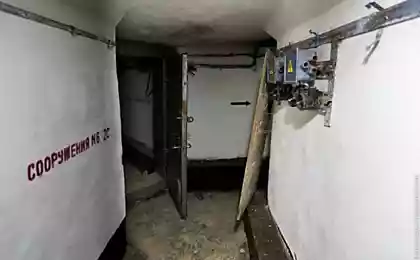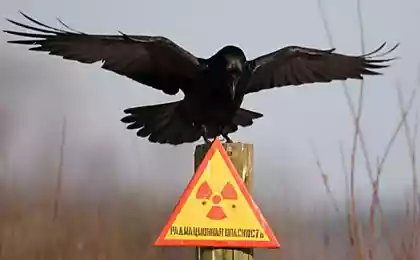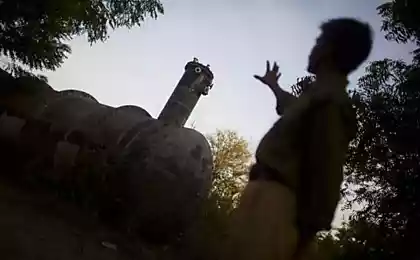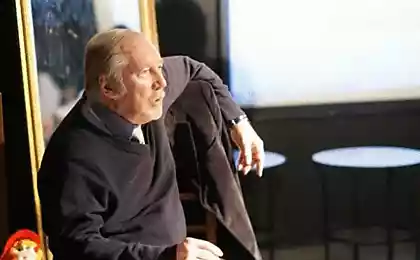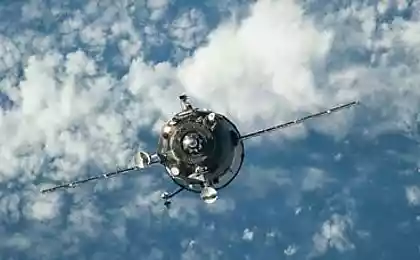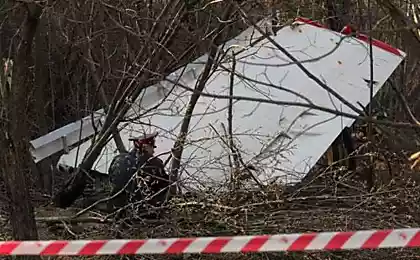936
On the verge of death: almost cosmic catastrophes occurred
Read about cosmic catastrophes occurred , frankly, sadly. Very sorry for the people, and to understand that the efforts of designers redundant critical systems, work MCC to control and manage the situation, preparation and heroism of the astronauts themselves - all this could not prevent a catastrophe, spoils the mood. In this sense, much more positive catastrophe that could happen, but were prevented by the talent of designers, hard-MCC, determined and skilled actions of the crew or just luck.
Vostok 1 h4> Yes, that Gagarin, in 1950. Memento mori. I>
It is hardly surprising that the incident that put the mission on the brink of disaster, began in the first flight.
Failure Reserve de-orbit
Disclaimer standard separation systems
But the biggest danger began at the end of the landing. Some irresponsible people doubt the heroism and high preparation Gagarin because he did not control the spacecraft in flight. Indeed, the control system of the "Vostok" with the normal operation did not imply an active piloting. But if Gagarin had parachuted down, did not act on time and correctly, in spite of the stress experienced by space flight, "carousel" after braking and delays with the separation compartments, he would have likely perished.
Disclaimer vent valve
The risk of drowning
Mercury-Redstone 4 h4>
Second space flight suborbital USA July 21, 1961 came to an end. Astronaut Gus Grissom successfully splashed down and waited for the helicopter, which was to raise the capsule and deliver it to the carrier. In anticipation of the readings he wrote, according to the instructions removed fuse emergency ejection hatch and took off his helmet and unfastened seatbelts chair (this accident probably saved his life). It took about ten minutes after landing, the helicopter was preparing to pick up the capsule to lift as there was a dull explosion. This system worked illegally emergency discharge hatch. The capsule began to fill water, Grissom with all possible speed gets out. The pilots of the helicopter first to be rescue capsule - they have repeatedly worked with astronauts and know that you can swim suit for a long time without the risk of drowning. But Grissom notices that it increasingly difficult to stay on the water - in a hurry evacuated from the capsule he forgot to close one of the valves suit, through which the suit is now taking on water! The valve is closed, but the suit has a lot of water, Grissom barely afloat. Meanwhile, a helicopter pilot, who had to pick up the capsule, realizes that he can not get it - it became too heavy from nalivsheysya into the water. The capsule is released, but not a helicopter flying to pick up Grissom. Instead, he turns around and goes in the direction of an aircraft carrier! The fact that the pilot sees on the dashboard of the signal "engine overheating" that this model helicopter is about five minutes of flight to engine failure. Pick up Grissom in such conditions makes no sense. As a result, the second astronaut picks up the helicopter, after a few minutes, which certainly seemed Grissom very long. After the astronauts lifted on board the second helicopter, the first thing he did was put on a life jacket. Subsequent investigation has shown that the most likely cause of the unauthorized operation of the emergency relief hatch - looseness external activation cord. System emergency discharge hatch can be activated from both inside and outside the capsule. Outside it was installed cord that was attached by only one screw. Looseness could cause the cord is released, but the excitement of the sea could create a random jerk the cord, which activates the system.
Video scene i>
Mercury-Atlas 6 h4>
February 20, 1962. The first American astronaut (John Glenn) entered orbit around the Earth. According to the plan the flight was to last seven turns. But early in the second round of the telemetry from the spacecraft to make the heart group leadership flights of chilled: lit indicator "section 51" said that planting shock and thermal shield is not fastened.
This meant that after braking heat shield will come down from his seat, and planting more shock unfold in space. The heat shield will not protect the ship from heating during reentry, and astronaut condemned to death. MCC Cape Canaveral, without naming the reasons for their concern and asked Glenn if he had heard any unusual sounds. Glenn said he did not hear. The team sent to MCC for a communication station operators to follow the "Segment 51" and began looking for a way to deal with the problem. The only thing that could come up with - lock shooting brake motors in the program launching. Iron belt, brake motors that were attached to the ship could hold the heat shield in the beginning of the descent, and when they will be burned up, the shield has to be held by the pressure of the incoming air. In the third round, still not speaking to Glenn about the reasons for the decision, said that his flight was reduced to three turns and recommended not to throw brake motors. Glenn tried to ask again about the reason for such a decision, but was told "Not now. That decision MCC. " The flight stopped after three turns, landing took place normally. Subsequent investigation revealed that the signal "Segment 51" was a mistake due to a faulty sensor, the real danger was not.
Mercury-Atlas 7 h4>
This flight was the first in which an astronaut he created a life-threatening problems that coped heroically. The fact that the fuel tanks for orientation systems "Mercury" were very small, and if you do not save fuel specifically, they would be enough very long. A astronaut Scott Carpenter working on a very busy program of experiments and being in uncomfortable conditions (temperature in the cabin due to the poor performance of the thermal control system reached 42 °), he is constantly unrolled ship in different directions, not particularly watching the fuel consumption. Already at the first turn of Carpenter spent almost all the fuel from the tank automatic orientation, and when the MCC asked him to switch to the manual orientation of the tank, in the second round of spent much of the fuel from there. As a result of the third round had to be carried out in the drift, disabling the automatic system for maintaining orientation. Before braking, fascinated by photography and "The Hunt for the snowflakes» abbr>, Carpenter ignored that the capsules have an error of orientation of 20 ° with 27 ° pitch and yaw. Automatic braking is blocked, Carpenter turned on brake motors manually. Due to an error orientation deceleration was partly "sideways", which reduced the total braking momentum. The ship flew over the landing point of 450 km. In addition, Carpenter forgot to disable the use of hand-orientation of the tank and the fuel it ended immediately after use brake motors! The astronauts were only a few percent of the fuel in the tank automatic orientation. If it is over - the orientation of the capsule lose a thermal shield forward and burn. Carpenter was lucky - fuel ended at an altitude of 24 kilometers, where the loss of orientation was no longer scary. But the flight of four hundred kilometers meant that the ships and aircraft, dedicated to the search and evacuation of astronauts were in a different area. Carpenter searched for nearly forty minutes, and, given that the search operation took place in the air, the press has already started speculation that the United States suffered its first loss of the space program. Curiously, Carpenter seems to be the end of life was sure that with the honor came out of a difficult situation, not realizing that he created it and.
Mercury-Atlas 9 h4>
The aim of the mission was a long space flight - as much as 34 hours. The flight took place under the program up to 19 turns (of the planned 22), which began to appear technical problems. At first light the indicator "0, 05g», which in normal operation signaled the beginning of the re-entry. It was an obvious failure, because the items in the cabin were weightless. Apparently, the sensor does not work properly due to a short circuit current (Cooper had problems with spills of water and urine, the fluid can close the wire). Twentieth turn left to fight with a gun orientation system, which took a wrong signal "0, 05g» as a guide to building a landing orientation. Disclaimer automatic program launching meant that I had to brake manually. Cooper read out from the earth a modified workflow for manual braking. In addition, in the turn of the twentieth refused artificial horizon - to determine the position of the ship was made possible only visually. At the turn of the 21 it was discovered growing partial pressure of carbon dioxide - refused to sink. Twenty minutes in the cockpit sounded the alarm - there were just two short-circuit in the system of automatic orientation. At 22, the last, refused to include a spare coil inverter machine orientation - to pilot the ship when returning from orbit could only manually. Cooper manually orientated vehicle braking by the stars and nighttime Shanghai and including the engine on command from Earth. Astronaut hand kept the ship on the right course, job tracking engine brake on the clock, hand shot off a block brake motors, manually oriented the same vehicle for braking in the dense layers of the atmosphere and manually piloting the ship all the way to the world, maintaining the correct orientation and fending fluctuations. Although full manual control Cooper managed to splash down to the smallest mistake - only 1, 8 km from the design point.
Voskhod 2 h4> Left - Belyaev, right - Leonov i>
Rich in life-threatening situation was flying "Voskhod-2".
The blow-up suit
Violation of the atmosphere
The refusal of the automatic landing
The latest adventure for the crew of "Voskhod-2" was the cold overnight. It was not fatal, but the trouble to deliver. The fact that the ship landed in a dense forest, where they could not sit down helicopters. The helicopter dropped food and warm clothes, quickly rescuers arrived, but the astronauts left the landing area (early spring, -25 ° C, snow, forest) until the third day. And unhealthy secrecy surrounding the Soviet space program, has led to the fact that while the astronauts were in the taiga, the press wrote that they rest in the country the regional party committee.
A film about Leonova i>
The popular science series "Deep Space". About the "Voskhod-2" to 45 minutes. I>
Gemini-6A h4>
December 12, 1965. Ready to start the ship "Gemini 6" with a crew of Walter Schirra and Thomas Stafford. Countdown begins the last ten seconds before the start, are beginning to start the engine, but, suddenly, with some unusual squealing, engine stops:
According to the instructions, the astronauts had to eject. But first, they have not felt any movement, which indicated that the rocket is not going to fall down or explode. And secondly, they did not want to eject. Even without taking into account the transfer of the mission to restore the ship after the bailout, very powerful catapult made this event very risky.
YM
href="http://habrahabr.ru/search/?target_type=posts&q=%5B%D0%A3%D0%9A%D0%9F%5D%20&order_by=date">серия
3D printing with sand using the Sun
Swiss physicist turned the Nokia N9 in quantum random number generator

